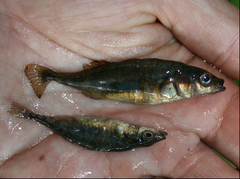| Description | Participants | Summaries | Products | Feature |
|---|
NIMBioS Working Group: Ecology of Niche Variation
 |
| Photo Credit: Daniel Bolnick/Univ. of Texas, Austin |
Consider the case of the three-spine stickleback. These tiny fish that thrive in oceans and in fresh water might appear to be the same, yet ecologists are finding that they are actually a diverse collection of very specialized individuals.
Understanding the ecological causes and consequences of such ecological variation was the goal of a group of scientists who met at the National Institute for Mathematical and Biological Synthesis (NIMBioS) at the University of Tennessee, Knoxville, July 27-29.
Population and Community Ecology Consequences of Intraspecific Niche Variation was the topic of a NIMBioS Working Group comprised of biologists and mathematicians from universities and other academic institutions across North America and Europe.
Traditionally, ecological theory has treated a population as a homogeneous set of individuals, implicitly assuming that individuals within a population are ecologically interchangeable, but individuals are often quite diverse, said Daniel Bolnick, Working Group co-organizer and assistant professor of biology at the University of Texas, Austin.
"Very little is known about how niche variation affects the ecological dynamics of a species or a community, and yet it is important to understand it in order to make accurate predictions about a population," he said.
In order to make effective management decisions, for example, conservation biologists need to know under what conditions a predator and its prey can co-exist together. "The problem is that a lot of the ecological models say that predator/prey populations are unstable, and yet we know that they can co-exist. So, what we want to know is how does variation in a population change what we know about population dynamics," Bolnick said.
One of the unique aspects of the Working Group is its interdisciplinary approach involving both biologists and mathematicians to studying the issue.
"By establishing connections between these usually separate fields, we hope to initiate a new field of mathematical ecology that melds genetics, evolution, and dynamic foraging behavior into ecological models that will determine how intraspecific variation affects ecological dynamics and community structure," Bolnick said.
"At present, mathematical theory is our only tool to determine the ecological effects of niche variation and make recommendations for empiricists," Bolnick added.
NIMBioS Working Groups are comprised of 10-15 invited participants and focus on specific questions related to mathematical biology. Each group typically meets two to three times over the course of two years at the Institute.
The National Institute for Mathematical and Biological Synthesis (NIMBioS) brings together researchers from around the world to collaborate across disciplinary boundaries to investigate solutions to basic and applied problems in the life sciences. NIMBioS is funded by the National Science Foundation in collaboration with the U.S. Department of Homeland Security and the U.S. Department of Agriculture, with additional support from The University of Tennessee, Knoxville.
For more information, contact Catherine Crawley at 865-974-9350 or ccrawley@nimbios.org
NIMBioS
1122 Volunteer Blvd., Suite 106
University of Tennessee
Knoxville,
TN 37996-3410
PH: (865) 974-9334
FAX: (865) 974-9461
Contact NIMBioS


